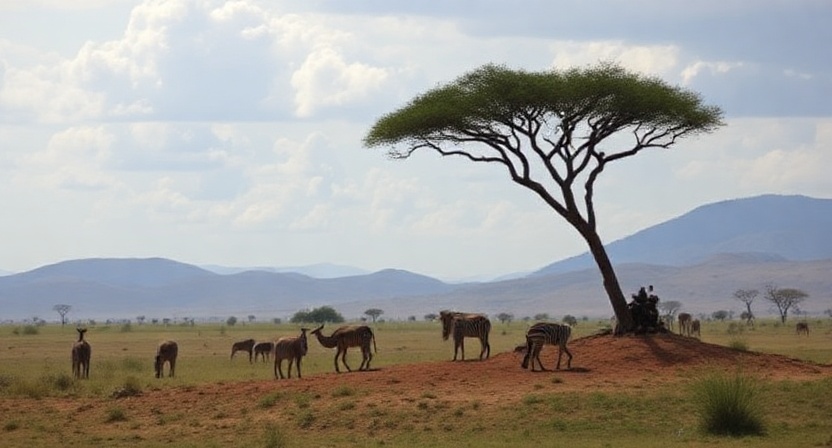Kenya Introduces New Conservation Fees to Boost its Tourism Services, Protect Wildlife and Support Sustainable Economic Growth
Kenya new conservation fees aim to enhance tourism services, protect wildlife, and promote sustainable growth in the country’s tourism sector.
Kenya Wildlife Service (KWS) within the Ministry of Tourism has introduced a new conservation fee system that takes effect on October 1, 2025. The new system aims at enhancing the country’s capacity to finance wildlife conservation activities and sustainable development of tourism. The new fees, which cover the national parks, reserves, and sanctuaries, will target enhancing tourism facilities and visitor experience in Kenya’s most visited wildlife sites.
This is Kenya’s first full review of park charges in 18 years, and it indicates the nation’s growing approach to tourism management and conservation funding. The fee structure amendments will be applied differently across visitor groups, namely East African citizens, Kenyan residents, international visitors, and African nationals, with an emphasis on preserving affordability for domestic travelers while generating extra revenue for sustainability and development initiatives.
Supporting Wildlife Conservation Efforts Through Increased Fees
The increase in conservation fees is a response to growing needs in wildlife conservation, with rising costs for anti-poaching efforts, habitat restoration, and biodiversity preservation. The government has committed to using the additional revenue to enhance park infrastructure, provide better facilities for tourists, and further protect endangered species in Kenya’s national parks.
The updated fees will play a crucial role in ensuring that Kenya can continue to offer world-class experiences for tourists while safeguarding its iconic wildlife, including elephants, lions, rhinos, and the various species found in Amboseli, Tsavo, and Nairobi National Parks.
Tourist Spending: Balancing Affordability and Revenue Generation
The new fee structure will provide a balanced approach to tourism pricing, allowing domestic tourists and East African citizens to benefit from affordable entry while ensuring that international tourists contribute appropriately to the costs of conservation and visitor services. While the increase in foreign tourism fees may be seen as a necessary step in ensuring financial sustainability, the government has pledged to maintain affordability for local visitors, especially those from East Africa.
This approach helps promote inclusive tourism, encouraging visitors from neighboring countries while also supporting the country’s long-term growth goals in the tourism and conservation sectors.
Boosting Infrastructure: Enhancements to Visitor Experience
One of the major advantages of the revised conservation fees is the opportunity to invest in tourism infrastructure improvements. With the growing influx of international visitors to Kenya’s top parks such as Amboseli, Tsavo, and Nairobi, the funds raised from the higher fees will be allocated toward upgrading facilities like tourist lodges, visitor centers, and transportation networks within the parks.
The government plans to build more eco-friendly and sustainable accommodations that will offer tourists luxury experiences while maintaining an environmentally conscious approach. In addition, the new fees will support the development of better road networks and public transport systems, making it easier for tourists to explore Kenya’s wildlife destinations.
Fostering Sustainable Tourism in Kenya: Eco-Friendly Practices and Conservation
Kenya’s tourism sector has increasingly focused on sustainability and eco-tourism. The increased conservation fees will be used to fund sustainable tourism projects, such as eco-lodges, solar-powered facilities, and environmentally friendly transport systems.
The goal is to create a tourism model that balances economic growth with environmental preservation. As eco-conscious travelers become more prevalent, Kenya is positioning itself as a leading destination for sustainable travel in Africa. The sustainable practices adopted by Kenya’s national parks will set an example for other African nations looking to preserve their natural resources while growing their tourism industries.
Growing Tourist Numbers: Strong Recovery in 2024 and Beyond
The strong growth in foreign tourist arrivals is reflected in the increased revenue for the Kenyan tourism sector. In 2024, Kenya welcomed millions of international visitors, with a 16.4% increase in foreign arrivals. This surge in tourist numbers is a positive indicator of Kenya’s growing reputation as a top wildlife tourism destination, and the revised conservation fees will help manage this increasing tourist demand by ensuring that tourism services remain of the highest quality.
Kenya’s focus on expanding its tourism offerings beyond just safari tourism to include beach tourism, cultural experiences, and adventure tourism has attracted a diverse range of visitors. This, in turn, supports the broader goals of economic diversification under Vision 2030, with tourism becoming a central pillar of the country’s growth strategy.
Tourism and Job Creation: Economic Benefits for Local Communities
The growth of tourism in Kenya directly benefits local communities, especially those living near major national parks and wildlife reserves. Tourism creates numerous job opportunities, ranging from park rangers and tour guides to local craftspeople and hospitality workers.
With increased revenue from higher conservation fees, Kenya’s tourism sector is poised to provide even more employment opportunities for local communities. Additionally, the government’s investment in training programs for local residents will help them develop skills in hospitality, tourism management, and cultural heritage preservation.
Global Competitiveness: Kenya’s Growing Position as a Top Wildlife Tourism Destination
Kenya has long been regarded as one of the top wildlife tourism destinations in the world, thanks to its rich biodiversity and the iconic national parks of Amboseli, Nairobi, and Tsavo. The introduction of higher conservation fees will help the country maintain its global competitiveness by ensuring that the quality of its tourism services remains high while continuing to attract the luxury market and eco-tourism travelers.
As more international tourists seek authentic wildlife experiences, Kenya will need to maintain its competitive edge by offering world-class experiences while ensuring that the environmental sustainability of its parks and reserves remains at the forefront of its tourism strategy.
The Role of Technology in Enhancing the Visitor Experience
As part of its efforts to improve tourism services, the Kenyan government is also focusing on digital solutions for tourism management. This includes the development of smart tourism platforms, mobile apps, and online booking systems to make it easier for visitors to plan their trips and access real-time information about park conditions, available accommodations, and tour packages.
The integration of technology will allow Kenya to enhance its visitor services, providing an efficient, seamless travel experience that meets the expectations of modern-day tourists. By improving access to digital tools, Kenya can provide travelers with more personalized and engaging ways to explore the country’s wildlife and natural attractions.
The Long-Term Impact: Strengthening Kenya’s Tourism Sustainability
The long-term impact of the increased conservation fees will be felt across the entire tourism ecosystem in Kenya, with higher revenue leading to improvements in park management, wildlife protection, and tourism infrastructure. The new pricing structure will ensure that Kenya’s tourism sector continues to thrive while maintaining a strong focus on sustainability and environmental preservation.
Through these initiatives, Kenya will remain a global leader in wildlife tourism and eco-tourism, providing a model for other nations looking to balance tourism growth with conservation goals. As tourist numbers rise and the industry evolves, Kenya is positioning itself for a bright, sustainable future in the global tourism market.
Kenya’s Tourism Future Is Bright with Sustainable Growth
The new conservation fees that have been introduced by the Kenya Wildlife Service are a fundamental measure towards the long-term sustainability of the nation’s tourism industry. By reconciling the growth of tourism with protection of wildlife, benefit to communities, and sustainable development, Kenya is already on its way towards being one of the leading wildlife tourism destinations in the world. These initiatives will go on to improve the country’s international competitiveness and offer sustainable and authentic travel experiences in the years to come.
The post Kenya Introduces New Conservation Fees to Boost its Tourism Services, Protect Wildlife and Support Sustainable Economic Growth appeared first on Travel and Tour World


Comments and Responses
Please login. Only community members can comment.